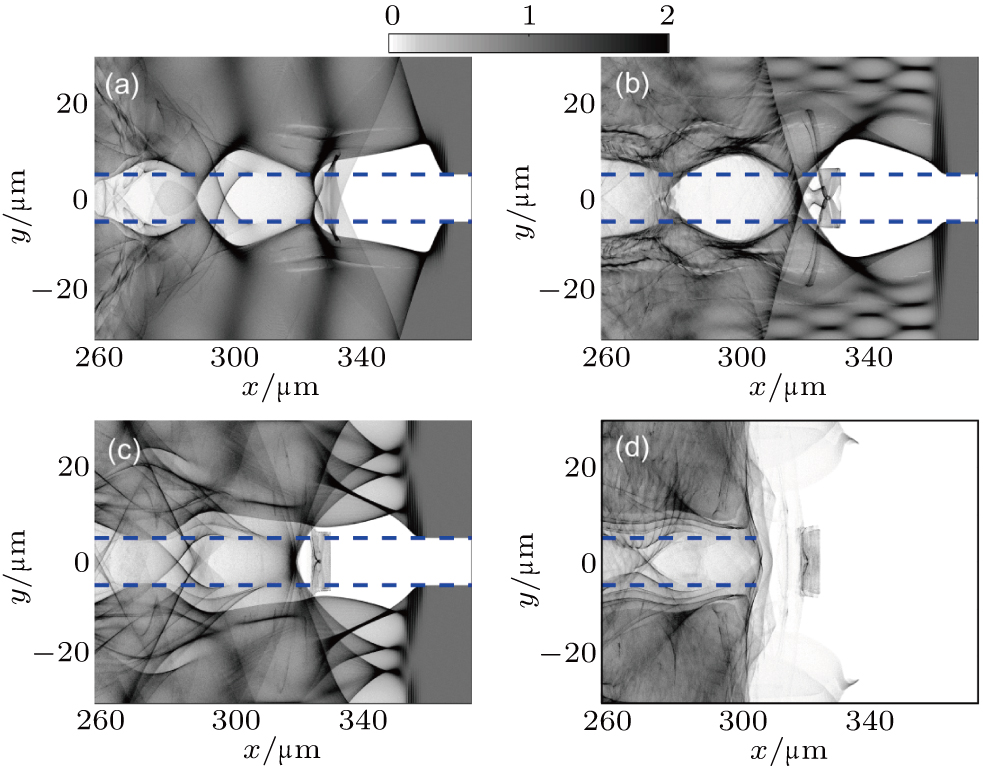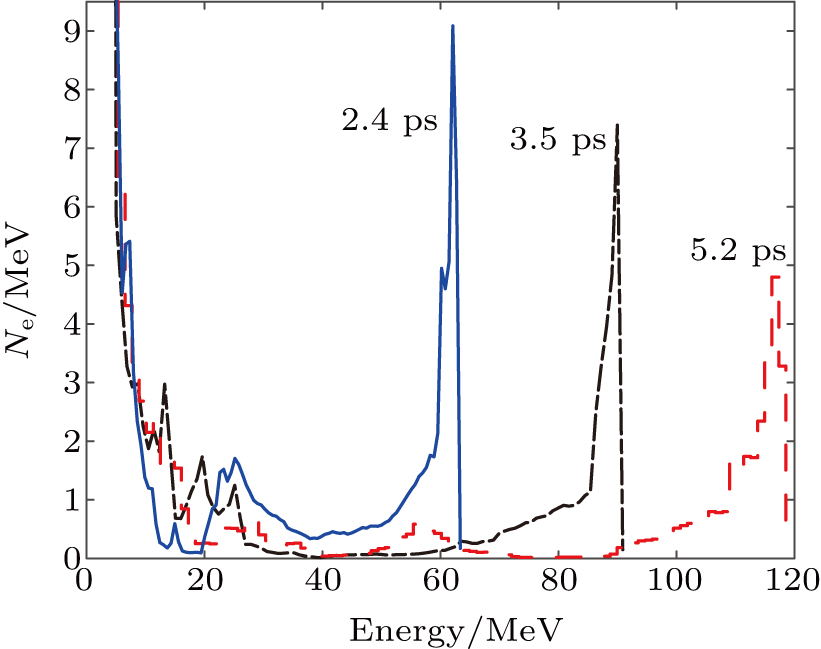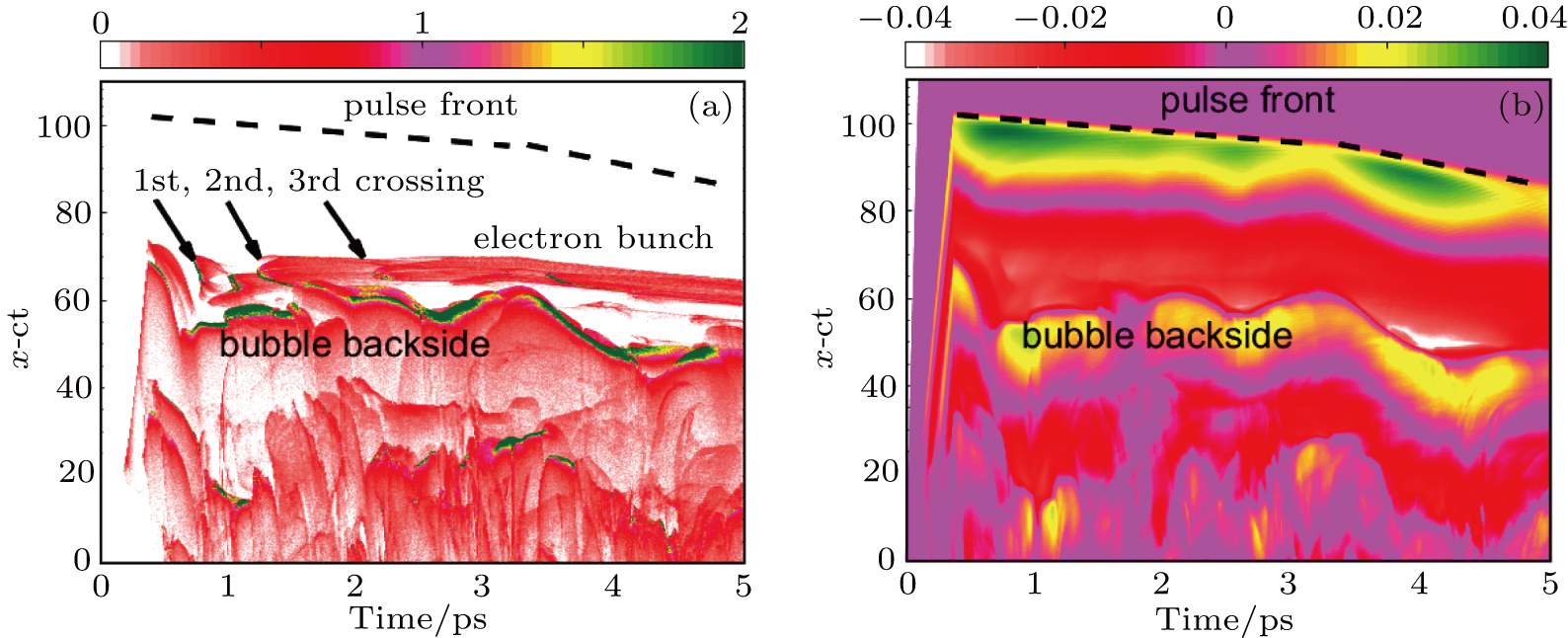† Corresponding author. E-mail:
The self-injection and acceleration of electrons in a hollow plasma channel driven by ultrashort intense laser pulses is investigated by Particle-in-Cell (PIC) simulations. It is shown that electrons from the bubble sheath will be self-injected into the hollow plasma channel and move radially towards the channel border due to the lack of focusing force in the hollow plasma channel. After several reflections near the channel wall by the strong focusing force, a self-injected electron bunch can be confined in the hollow plasma channel and quasi-phase-stably accelerated forward for the whole laser–plasma interaction process. These electrons using optical and plasma-related self-injection method can be self-organized to remain in the rear of the bubble, where the accelerating electric field is transversely uniform and nearly plateau along the propagation axis. Therefore, the self-injected electron bunch can be accelerated in a steady state without obvious oscillation and has a high quality with narrow energy spread and low divergence.
Laser-driven wakefield acceleration (LWFA) is one of the most promising schemes for achieving compact and affordable accelerators, providing large accelerating gradient orders of magnitude higher than those available in conventional radio-frequency accelerators.[1] Therefore, charged particle acceleration in the laser–plasma interactions has attracted great interest since the LWFA mechanism was first proposed by Tajima and Dawson in 1979.[2] Thanks to the development of high-power laser technologies, significant progress has been made in 2004 when the quasi-monoenergetic electron bunches were first obtained in experiments.[3–5] Recently, electron bunches with the energy up to 4.2 GeV have been generated in a 9-cm plasma waveguide using a 40-fs laser pulse with 16-J energy.[6] These significant experimental results were obtained in the bubble regime when a short intense laser pulse almost expels electrons completely from the first half of the plasma wave. The longitudinal electric field in the cavitated region is uniform in the transverse direction and linear in propagation axis so that the self-injected electron bunch with duration less than about 10 fs can get monoenergetic.[7] These electron bunches have a lot of potential applications such as generation of X and γ rays,[8–10] ultrafast imaging,[11] cancer therapy,[12] radiotherapy,[13] etc.
Although there have been many theoretical and numerical investigations of LWFA and the scaling laws have also been found,[14–18] to obtain high-quality electron bunches in practical experiments is a challenging task due to the complexity of the strongly nonlinear bubble regime. As we know, the laser pulse interacts with plasma electrons at the very front and the major part of the laser pulse propagates freely in the blow-out region. Thus, the pulse tail gradually overtakes its head, where an optical shock is formed and the pulse etches back.[16] All these lead to the pulse shortening and faster dephasing, which in turn decreases slowly the group velocity of the laser pulse. Consequently, the self-injected electron bunch will run into the decelerating phase of the bubble to limit the maximum energy gain and enlarge the energy spread. At the same time, these relativistic self-injected electrons can easily come into betatron resonance because of the transverse focusing field in the bubble regime. Thus, it will blow up the electron bunch emittance and increase divergence.[9]
Numerous methods have been proposed to optimize the quality of the self-injected electron bunch and improve its stability, such as pulse colliding injection,[19] ionization-induced injection,[20–23] density transition injection,[24,25] guiding of the laser pulse in a performed parabolic[6,26,27] or hollow channel,[28] etc. Among those, the hollow plasma channel is considered as an efficient way to overcome the drawbacks in the uniform plasma and significantly optimize the electron acceleration. The lack of ion cavity in the hollow plasma channel is favorable to increase the effective phase velocity of the bubble and the dephasing length and reduce remarkably the focusing force acting on the electrons in the bubble regime. It is very important for electron acceleration to tunable control in experiments. The parameters of the hollow plasma channel can provide independently control over the focusing and accelerating field in the channel.[29] Recently Pukhov et al. derived scaling laws for deep plasma channel with a zero density on axis driven by ultrashort pancake-like laser pulses and observed a witness beam with energy up to 7.5 GeV and only 0.3% total energy spread in numerical simultions.[28] Further, Thomas et al. obtained the generalization of the bubble theory for a radially inhomogeneous plasma and it can predict the shortening and steepening of the bubble.[30] Yi et al. used the hollow plasma channel to overcome the defocusing of the positively charged witness beam in the bubble regime and accelerate the latter up to 4-TeV energy with low emittance.[31,32] However, high-quality witness bunches in these schemes should be injected externally into the bubble regime. It requires such bunches with energy GeV or TeV level must be generated from conventional radio-frequency accelerator.[19] Recently the first experimental demonstration of creating an extended hollow plasma channel is encouraging for undertaking future the generation of high-quality electron bunch at intense laser facilities.[33]
In this paper, we focus on the self-injection and acceleration of electron in the bubble regime of the hollow plasma channel driven by the Guassian-shaped laser pulses, which are used commonly in worldwide experiments. By optimizing the parameters of laser pulse and hollow plasma channel, it finds that when the radius of the hollow plasma channle matches the spot size of the laser pulse in a rarefied plasma, electrons from the bubble sheath can be self-injected into the rear of the bubble. The dynamics of the electrons in the whole interaction process will be discussed. The focusing field is almost zero in the hollow plasma channel, while it is strong around the periphery of the hollow plasma channel in the bubble regime. Self-injected electrons can be confined in the channel and are quasi-phase-stably accelerated in the rear of the bubble, where the accelerating electric field is uniform transversely and flatten in propagating direction. Therefore, a self-injection electron bunch with low energy spread and divergence can preserve a steady state in the whole laser–plasma interactions without obvious quality degradation.
We carried out two-dimensional (2D) particle-in-cell (PIC) simulations using VORPAL code to demonstrate electron self-injection and acceleration in hollow plasma channels driven by laser pulses.[34] In order to comparison with the existing results,[15] we choose the same laser parameters as in the latter. In the simulations, a bi-Gaussian laser pulse is irradiated into a hollow plasma channel from the left boundary (x = 0). The pulse envelope is 















Figure
It is very important to analyze the quality of the self-injected electron bunch in our scenario. The self-injected bunch is accelerated to 117 MeV of the peak energy with 2.9% energy spread at t = 5.2 ps when it moves out of the plasma slab, as shown in Fig. 

 | Fig. 3. The energy distribution of electrons as a function of the divergence angle at t= 0.5 ps (a), 1.23 ps (b), 3.5 ps (c), and 5.2 ps (d), respectively. The electron density is in arbitrary unit. |
In order to further investigate the generation of the high-quality electron bunch in the hollow plasma channel, we presented the spatial distributions of transverse focusing field 


Actually, one of the remarkable advantages in the proposal is that the central intensity of the laser pulse propagates in the hollow plasma channel with the light speed for the whole laser–plasma interactions and the self-injected electrons is catching up with the laser pulse and continuously obtaining energies, until they reach the dephasing region. Figure
As a comparison, simulations with the same laser pulse as that in Fig. 


In order to investigate the effects of plasma densities on the quality of the self-injected electron bunch, the same laser pulse as that in Fig. 







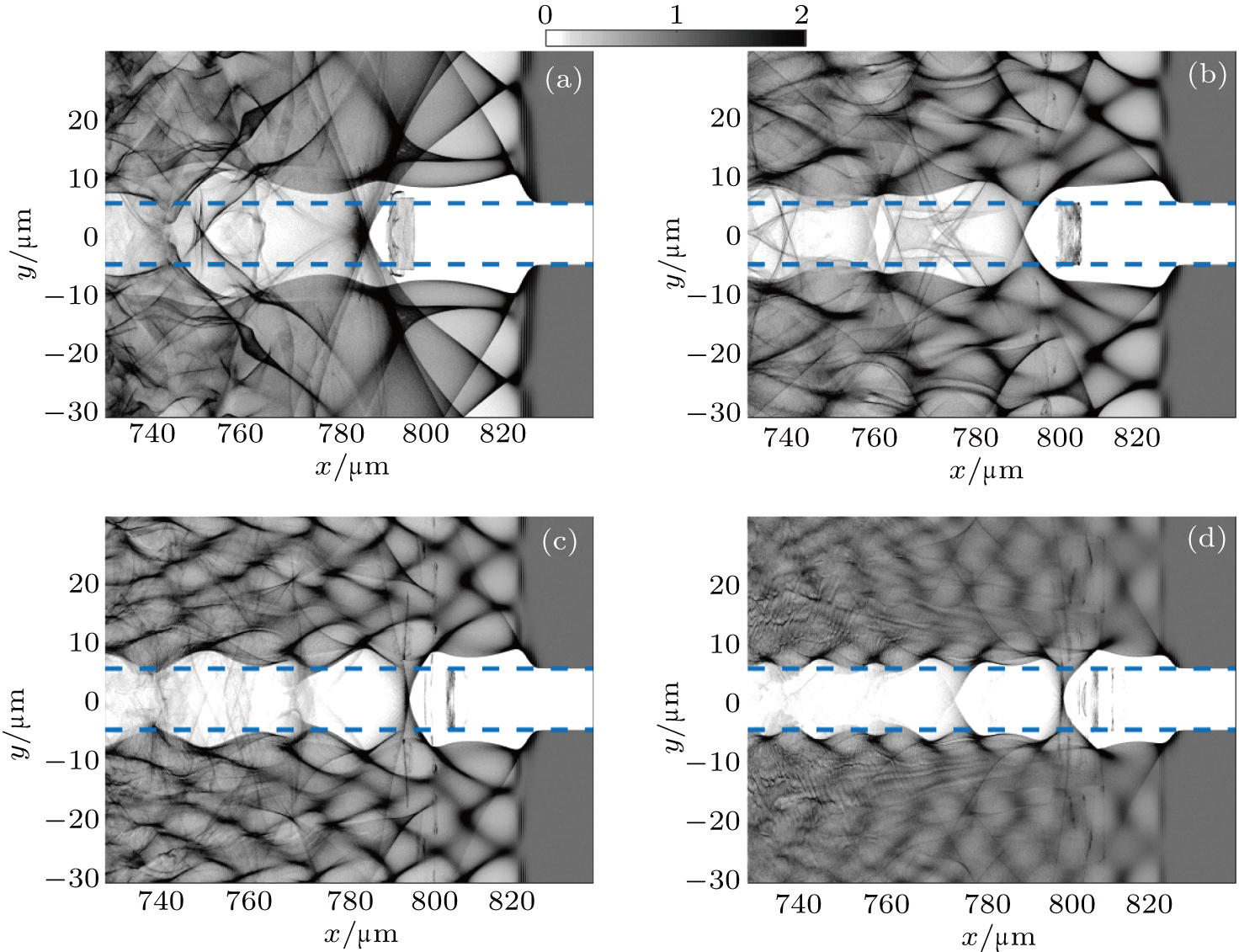 | Fig. 7. The distributions of electrons at t=2.8 ps with density 



|
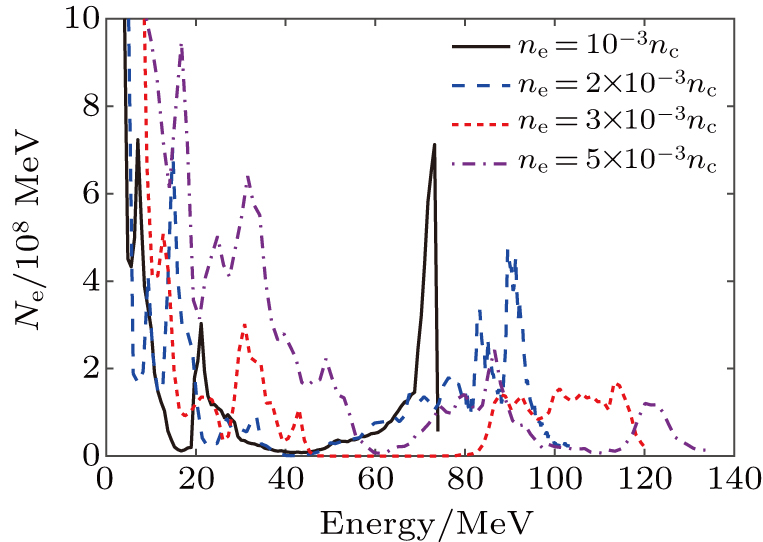 | Fig. 8. The energy spectra of electrons at t=2.8 ps for different densities 



|
In summary, the self-injection and acceleration of electrons in the hollow plasma channel driven by the laser pulse has been investigated. The whole acceleration process of electrons could be roughly considered as the following three stages: (i) electron self-injection stage, (ii) electron oscillation stage, and (iii) electron quasi phase-stable acceleration stage. Due to no focusing field inside the channel, the self-injected electrons move radially and then they are reflected by the radial focusing force near the channel boundary. After several oscillations between the upper and lower boundaries of the hollow plasma channel, a self-injected electron bunch is formed in the rear of the bubble. And other self-injected electrons behind the bunch in the bubble will be dispersed out of the channel because there is no confining potential well around the channel edges. The self-injected electron bunch could be quasi-phase-stably accelerated forward in the whole laser–plasma interactions till the dephasing region. Meanwhile, the accelerating electric field experienced by the self-injected electron bunch is transversely uniform and nearly flatten longitudinally. Thus, a wide self-injection electron bunch can be generated and accelerated stably to the peak energy 117 MeV with the energy spread of only 2.9%.
The authors would like to thank Prof. Hong-Yu Wang for his contributions to the computational technique.
| 1 | |
| 2 | |
| 3 | |
| 4 | |
| 5 | |
| 6 | |
| 7 | |
| 8 | |
| 9 | |
| 10 | |
| 11 | |
| 12 | |
| 13 | |
| 14 | |
| 15 | |
| 16 | |
| 17 | |
| 18 | |
| 19 | |
| 20 | |
| 21 | |
| 22 | |
| 23 | |
| 24 | |
| 25 | |
| 26 | |
| 27 | |
| 28 | |
| 29 | |
| 30 | |
| 31 | |
| 32 | |
| 33 | |
| 34 |


